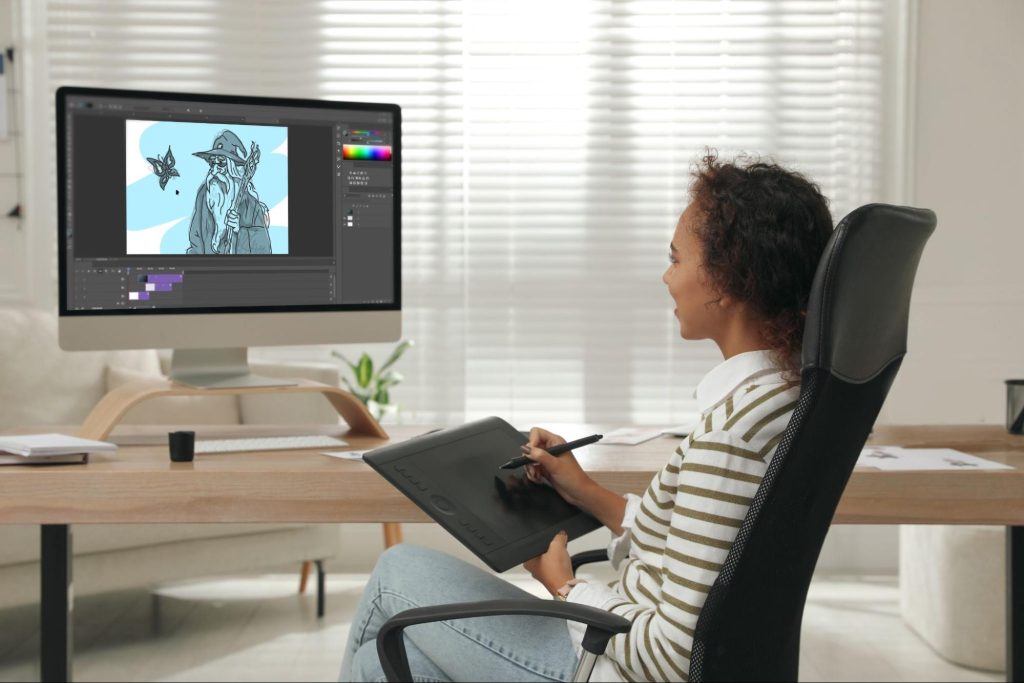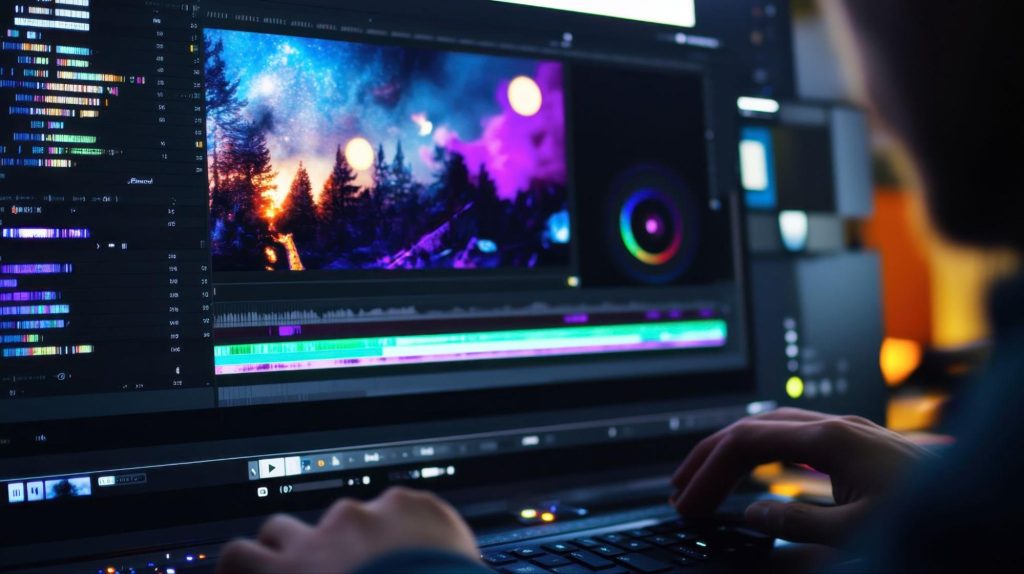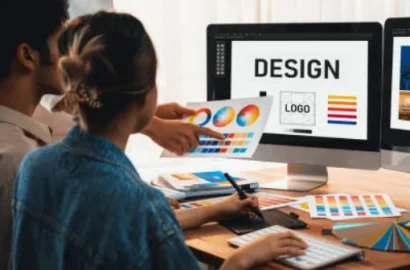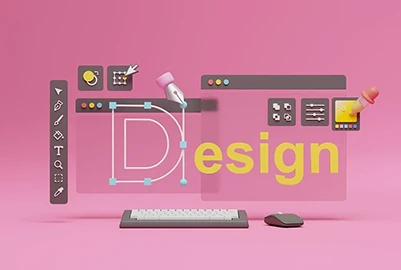So you want to become a motion graphic designer — but where do you begin? Consider this your ultimate career guide, complete with salary data, top skills, and actionable steps.
If you’re looking for a career that’s technical, creative, collaborative, and varied, motion graphic design should be high on your list.
Motion graphics designers are the experts who bring static content to life — giving us animated logos, dynamic typography, and unforgettable movie title sequences. They transform everyday visuals into captivating animations, making the digital world feel so much more engaging and immersive.
It’s an exciting career path, and we’re not surprised you’re here to learn all about it. In this guide, we’ll explore:
- What is motion graphic design?
- What does a motion graphics designer do?
- What skills do motion graphic designers need?
- How much do motion graphic designers earn?
- How long does it take to become a motion graphic designer?
- How to become a motion graphics designer (step-by-step)
- Motion graphics designer jobs and career paths
- Learn more about forging a career in design
So what exactly does a motion graphics designer do? And how can you become one? Let’s find out.
What is motion graphic design?
Motion graphic design is a specialist branch of graphic design. It’s all about creating dynamic content for digital media — using movement, transitions, and special effects to bring design elements to life.
You’ve probably seen motion graphics in animated logos, social media ads, explainer videos, and movie title sequences. Motion design is everywhere, and it helps to communicate with the audience in a memorable and engaging way. As such, it plays a crucial role in industries like advertising, entertainment, and digital marketing.
At this point, you may be thinking that motion graphic design sounds similar to animation design. And you’re right: they both work with movement to enhance visual communication.
But, while animation design focuses on telling a story through characters, scenes, and dialogue (think cartoons and animated films), motion design tends to focus on design-driven movement. That is: injecting motion into otherwise static elements like typography, logos, and abstract shapes.
Unlike animation, motion graphic design doesn’t necessarily follow a storyline or a narrative; it’s more about presenting visual elements in a more engaging way.
That’s motion graphic design in a nutshell. So how does this translate in terms of the day-to-day work of a motion designer? Let’s take a look.
What does a motion graphics designer do?
Motion graphics designers are responsible for creating animated (moving) visuals that communicate a message, enhance storytelling, or add a dynamic element to digital content.
Motion designers work across a broad variety of projects and contexts — from commercials and social media ads to film title sequences and website animations. If it involves a moving graphic, the chances are that it’s been created by a motion graphics designer!
But, as we mentioned before, it’s important to distinguish between the work of a motion graphics designer and an animation designer. While animators focus on character-based storytelling, motion graphic designers primarily animate elements like text, shapes, and icons.

So what exactly does the job involve?
Let’s say you’re a motion graphics designer working at a digital marketing agency. Your day might start with brainstorming ideas for an animated social media ad. You’d sketch out a storyboard, create individual design elements in Adobe Illustrator, and then bring them to life using specialist motion graphics software like Adobe After Effects.
In the afternoon, you might work on motion graphics for a client’s website, ensuring smooth animations and transitions that enhance the user experience.
As you can see, it’s a pretty hands-on role that requires plenty of creativity, collaboration, and the ability to juggle many tasks at once.
Speaking of tasks…what are the main tasks and responsibilities of a motion graphic designer? While it varies depending on the role and the industry, a typical to-do list might include:
- Creating animated visuals for videos, advertisements, websites, and company presentations.
- Designing and animating typography to highlight key messages.
- Developing storyboards and style frames to plan out animations.
- Adding visual effects (VFX) to enhance videos or digital content.
- Collaborating with designers, video editors, and marketers to align motion graphics with brand identity and messaging.
- Optimizing animations for different platforms, such as social media, mobile apps, and websites.
Note that motion graphics designers don’t work in a vacuum. They often collaborate closely with graphic designers, video editors, creative directors, and marketing teams to bring projects to life and contribute to a broader communication strategy.
In industries like film and television, they might also collaborate with visual effects (VFX) artists and animators to integrate motion graphics into larger productions (like films or video games).
No matter where they work, motion graphics designers play a crucial role in making digital content more dynamic and engaging — be that crafting an eye-catching logo animation, enhancing a product demo, or designing compelling explainer videos.
It’s a creative and varied role that can involve all kinds of exciting projects. And, like most design jobs, it requires a solid mix of technical and soft skills. Let’s explore those now.

What skills do motion graphic designers need?
To become a motion graphics designer, you’ll need to demonstrate the following skills and expertise.
1. Hard skills:
Motion graphic designers need certain technical, job-specific knowledge and skills to excel in the role, including:
- Graphic design fundamentals such as typography, color theory, composition, branding, and other foundational graphic design concepts and principles.
- Proficiency in motion design software such as Adobe After Effects (the industry-standard tool for motion design), Cinema 4D, and Blender.
- Animation principles such as timing, easing, and movement.
- Storyboarding and visual scripting: This includes being able to plan animations with sketches and digital mockups to ensure a clear creative direction before production begins.
- Video editing and compositing, including proficiency in software like Premiere Pro and DaVinci Resolve.
Depending on the role, motion designers may also be required to have domain-specific knowledge — such as designing for social media, for example, or branding.
2. Soft skills:
These are the interpersonal skills that enable you to collaborate with stakeholders and ensure a smooth, efficient workflow. The most important soft skills for a motion graphic designer include:
- Creativity and visual storytelling: Motion graphics designers must think visually and find compelling ways to communicate ideas through movement, color, and typography.
- Attention to detail: Small tweaks in timing, easing, or transitions can make a huge difference in animation quality, so a keen eye for detail is key.
- Time management: Many projects have tight deadlines, so being able to prioritize tasks and work efficiently is crucial.
- Collaboration and communication: Motion designers work closely with creative directors, video editors, marketers, and clients, so the ability to articulate ideas and receive feedback is essential.
- Problem-solving: Whether troubleshooting animation glitches or finding innovative ways to execute a concept, motion graphics designers need strong critical thinking skills.
3. What qualifications do you need to become a motion graphics designer?
There’s no single, gold-standard qualification you need to become a motion graphics designer. People enter the field through many different routes, and from all different kinds of professional and educational backgrounds.
Of course, a qualification in graphic design, animation, or multimedia arts can be helpful, but it’s not essential. What really matters is a strong portfolio that showcases your skills in action (we’ll talk more about that later when we show you how to become a motion graphics designer).
And bear in mind that you can get a reputable design qualification without going to university. There are many online courses out there that offer structured, hands-on, and industry-relevant training in motion graphic design — enabling you to learn from experts and build your portfolio without investing in a full-on degree program.
Many programs also offer a certificate, which can be extremely valuable when it comes to applying for jobs.
So, in short: you don’t need a specific qualification to become a motion graphic designer, but a specialist course can be a great way to kick-start your career if you’re new to the field.
We’ll take a closer look at exactly what it takes to become a motion graphic designer shortly. But first, let’s discuss the topic of salary.

How much do motion graphic designers earn?
If you’re thinking about becoming a motion graphic designer, you’ll want to know what kind of salary to expect.
A motion graphic designer’s salary is influenced by many factors — including industry, company type, location, and experience. So, as you consider the average salary figures we’re about to share, just bear in mind that they should be used as a benchmark rather than a hard-and-fast number.
With that, let’s consider the average salary for a motion graphic designer in a handful of locations:
- In the United States, the average salary for a motion graphic designer is around $75,000 per year (Source: Glassdoor).
- In India, the average salary for a motion graphic designer is around ₹5,57,000 per year (Source: Glassdoor).
- In the UK, the average salary for a motion graphic designer is around £33,000 per year (Source: Glassdoor).
If you’d like to determine your earning potential in a different location, use websites like Glassdoor and Indeed to pull up the latest salary data for specific countries, cities, and job titles.
Curious to see how a motion designer’s salary compares to other design job titles? Check out this guide to the top graphic design jobs and their salaries.
How long does it take to become a motion graphic designer?
The time it takes to become a motion graphics designer depends primarily on your starting point and your learning pace.
If you already have a background in graphic design or video editing, you can certainly transition into motion graphics in just a few months — as long as you focus your learning and get plenty of hands-on practice.
If you’re a complete beginner, you’ll need to first spend time learning graphic design fundamentals before you jump into motion graphics. Still, with a well-structured course, you can learn the necessary skills and get job-ready within six months to a year.
The key is to find a learning approach — and pace — that works for you. If you’re already working, you’ll need to fit your studies around your existing schedule. But, with consistency and dedication, you can steadily work towards a new career in motion graphic design.
On that note: let’s outline the exact steps you’ll need to follow to become a motion graphics designer.
How to become a motion graphics designer (step-by-step)
You don’t need a degree to become a motion graphics designer, but it does take dedication, hands-on practice, and the right learning resources.
Ready to break into the field? Here’s a step-by-step roadmap you can follow.
1. Learn the fundamentals of design and animation
Motion graphic design is rooted in core design principles like composition, typography design, and color theory, as well as animation concepts like timing and easing. If you’re new to design, you’ll need to start by learning these basics.
Refer to books, free tutorials, and beginner-friendly online courses to build a solid foundation. We’ve rounded up some of the best free graphic design courses in this guide — check it out as a starting point.
2. Master industry-standard tools and software
To create motion graphics, you’ll need proficiency in key tools such as Adobe After Effects (the industry’s go-to software for motion graphics design), Adobe Illustrator, and Photoshop — which are essential for creating static design elements that you can later animate.
If you’re interested in 3D motion graphics, you’ll also want to dip into tools like Cinema 4D and Blender.
Start by exploring online tutorials, then work on small projects to get comfortable with each tool and master specific functions and techniques.
We’ve rounded up some free Photoshop courses here and some Adobe Illustrator courses here.

3. Fast-track your learning with a structured course
You can learn a lot about motion graphics design with free resources. But if you want to really level up your skills and get ready for the job market, consider a professional course.
A well-designed course will help you build industry-relevant skills, gain a credible qualification, and develop a strong portfolio — everything you’ll need to apply for, and land, a motion graphics designer role.
Look for courses that include hands-on projects and expert guidance, either through live instruction or one-to-one mentorship — like AND Academy’s Motion Graphics Design Course.
A quality course will not only fast-track your learning; it will also help you make valuable industry connections and learn how to market yourself as a qualified motion designer.
4. Apply your skills to real projects
Motion design is a very hands-on field, so the more practice you can get, the better.
Start by animating simple logos, creating kinetic typography, or designing short social media animations — anything that allows you to apply your skills, learn from your mistakes, and refine your technique.
And remember: you’re not aiming for perfection here. The goal is to practice as much as possible and learn by doing.
5. Build a strong portfolio
When it comes to applying for jobs or freelance work, your portfolio is your most important asset. It provides a showcase of motion design projects you’ve worked on — and proves to employers that you’re a skilled and capable motion designer.
Choose a mix of projects that highlight your animation skills, creativity, and design process. And, rest assured that you don’t need a ton of case studies to build a strong portfolio; quality over quantity is the key here.
You can learn more about how to create an outstanding design portfolio in this guide.
6. Network and collaborate
Becoming a motion graphics designer is not just about learning the necessary skills. Networking is key and can prove critical in getting your foot in the door.
Connect with other designers, editors, and creatives in the industry through LinkedIn and other relevant communities — like Motion on Discord or r/motiongraphics on Reddit.
Engaging with other professionals in the field can open doors to future opportunities, as well as provide valuable feedback, support, and guidance.
7. Apply for jobs (or start freelancing)
You’ve learned the essential skills, built a solid portfolio, and are in the process of growing your network. Excellent! Now you’re ready to start applying for paid work.
If you’re switching into design from an unrelated career, look for entry-level motion design jobs at agencies, studios, or in-house marketing teams.
If you’re keen to build a freelance career (or get more hands-on experience before you apply for jobs), create a profile on platforms like Upwork, Fiverr, and Behance Jobs. Many motion designers start with smaller projects and work their way up to bigger clients as they gain experience.
As you apply for work, bear in mind that landing your first gig may take time. No one becomes a motion graphics designer overnight — but rest assured that your perseverance will pay off!
Motion graphics designer jobs and career paths
Once you’ve built the skills (and portfolio) needed to break into motion design, you may be wondering: what’s next?
The good news is that motion graphic designers are in demand across a whole host of industries — from advertising and entertainment to tech and corporate branding. Whether you’re looking for a full-time role, freelance opportunities, or even the possibility of launching your own studio one day, there are plenty of career paths to explore.
Indeed, ‘motion graphics designer’ is just one of many job titles you might end up with. Let’s explore some additional roles and pathways you may come across in the field.
Motion graphic designer job titles and career paths
Besides motion graphic designer, you might also apply for roles such as:
- Motion designer: a broad job title covering 2D and 3D animation work for marketing, social media, UI animations, and more (often used interchangeably with ‘motion graphic designer’).
- Animator or animation designer: typically focused on character design, animation, and storytelling-focused motion graphics for film, TV, and games.
- Visual effects (VFX) artist: specializes in creating CGI (computer-generated imagery), compositing, and advanced visual effects for movies, commercials, and video games.
- Video editor with motion graphics: a hybrid role where video editing is the primary focus, but motion design skills are used to enhance footage with animated elements.
- UI motion designer: works on micro-interactions and animations for apps, websites, and digital products to improve the user experience.
As you can see, there’s plenty of variety within the field; you’re not fixed to a specific pathway or job title. Motion graphic designers also have great flexibility in where they work — which we’ll look at next.

Where can motion graphic designers work?
Motion graphic design skills are valuable in many different sectors and environments. As you move through your career, you might find yourself working in:
- Creative agencies: producing motion graphics for branding, advertisements, and marketing campaigns.
- In-house teams: working within a company’s marketing or design team to create branded video content, product demos, and social media animations.
- Film and TV production: creating title sequences, visual effects, and animated graphics for entertainment projects.
- Freelance or self-employment: offering motion design services to clients across industries, giving you the freedom to choose your projects and work remotely.
- Tech and gaming: contributing to UI/UX animations, promotional content, and game cinematics.
Opportunities for career growth and specialization in motion design
As you gain experience and develop your skills, you’ll find plenty of opportunities to specialize or grow within the field. Further down the line, you may move into more senior positions such as:
- Lead or Senior Motion Designer: with more experience, you could take on leadership roles where you oversee larger teams and more strategic projects.
- Creative Director: in this role, you would be responsible for guiding the overall vision of a motion design project or campaign, working closely with clients, and leading design teams.
- VFX Supervisor: a specialized position in larger film or animation studios, overseeing the creation of complex visual effects.
- Founder: if you’re an entrepreneur at heart, you might work towards starting your own studio or agency, allowing you to work on diverse projects and build your own team.
That’s the beauty of learning motion graphic design: you’ll have a great variety of paths and opportunities available, allowing you to build your career around your goals and interests. Whether you prefer the fast-paced world of advertising, the creativity of gaming, or the artistry of film, your motion design skills can take you there!
Learn more about forging a career in design
We hope you’ve enjoyed learning all about the role of a motion graphics designer. If you’re confident that this is a career path you’d like to pursue, use our step-by-step roadmap to guide you as you learn the fundamentals, grow your network, and build your portfolio.
Still weighing up your options? Then keep exploring with these guides:
- What Is a Character Designer and How Can You Become One?
- What Is Visual Communication Design and What Does a Visual Communication Designer Do?
- What Is a UI Developer and How Can You Become One?
Next Steps
To learn more about graphic design, visit our blog, or consider the following resources:
- Watch this session by design veteran and AND’s Academic Head, Prachi Mittal, and our Course Lead, Soumya Tiwari.
- Talk to a course advisor to discuss how you can transform your career with one of our courses.
- Pursue our Graphic Design courses – all courses are taught through live, interactive classes by industry experts, and some even offer a Job Guarantee.
- Take advantage of the scholarship and funding options that come with our courses to overcome any financial hurdle on the path of your career transformation.
Note: All information and/or data from external sources is believed to be accurate as of the date of publication.









